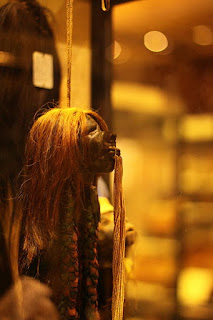 |
| A Dayak headhunter, Borneo.en.wipedia.org |
 |
| A Mississippian-era priest, with a ceremonial flint mace and a severed head. By Herb Roe, based on a repousse copper plate. en.wikipedia.org |
 |
| A Jivaro shrunken head, located in the Pitt Rivers Museum, Oxford. Photo courtesy of Narayan.www.kashgar.com |
Why did this gory practice exist in historic times? why do people take heads and keep them as trophies? After all wild animals kill for survival and not for pleasure. Why did men resort to violence, kill his own people, remove their heads and keep them as trophies? According to scholars, head hunting which is rooted in cannibalism was a way of structuring, reinforcing, and defending hierarchical relationships between communities and individuals. The assumption was based on the belief of existence of a more or less material soul matter on which all life depends. Life force or soul power could be harnessed through capture. Since the soul matter is confined to head, possession of it contributes to the fertility of the human population, livestock, and crops. That the head is the seat of soul was the primary concept of headhunting. Some Anthropologists do not rule out ritual killing, display of manhood and cannibalism to make the enemies servile and submissive. In some headhunting communities, killing and taking the head of a person is a sign of bravery and it marks the transition from childhood to adulthood.
As far as India is concerned headhunting was prevalent among the Naga tribes of NE India and Myanmar(previously Burma). Headhunting never existed in rest of India. In the south of Vindhya mountain such a thing was uncommon. There are thousands of tribes living across India and violence was not part of their culture. In fact when John Sullivan, Collector of Coimbatore in the 1800s discovered Nilagiri hills (now in Tamil Nadu) and built a cottage there, the Toda tribes (one of the oldest tribes in India) not only gave him their land but also were helpful to him through out his stay there.
 |
| Head hunting days of old in nagaland, India.www.kashgar.com.au |
 |
| A British India 1940 map showing Nagaland and Kohima City as part of Assam.en.wikipedia.org |
Tribes living south of the Brahmaputra River—Garos, Khasis, Nagas, and Kukis in Assam, India were headhunters. Particularly the Mizo tribes were ferocious warriors. Headhunting in Assam was generally carried on by parties of raiders. Their forte was to take the enemies by surprise by using special tactics to achieve their ends. Their habitat was also helpful to them because they lived in the wooded, thickly forested areas where they could pick up vantage points to make a surprise assault in a flash and they could chase the enemies by stalking in the dense plant and tree cover. The headhunters were invariably only after the head of a man, not his money or jewelry.
During the colonial period in 1800s and early 1900s the British owned tea estates in the upper reaches of the foot hills of the Himalayas in Assam and the Naga tribes and their ferocious raids on the British estates were a big menace under the East India company rule and later by the British crown.
The practice of headhunting that existed in the past reflects on the odd and bizarre behavior of certain human communities. For normal human beings, such stories may cause revulsion and rejection. As for researchers, such dreaded custom is a fodder for them to delve into the abysmal depth of mysterious human mind that does wonders on one hand and bizarre things on the other. In the 1700s and 1800s the expansion of colonial rule in many countries and the ubiquitous presence of Christian preaches in the nooks and corners of the world and their watchful and curious eyes impacted on the gruesome practice which reduced drastically in the later years.
Tit Bits:
01. Headhunting existed among Austronesian people in Southeast Asia and the Pacific Islands. of Melanesia, including New Guinea.
02. A missionary found 10,000 skulls on Goaribari Island in 1901 in New Guinea.
03. There existed ''annual headhunting'' rituals among the Mappurondo religious minority, an upland tribe in the southwest part of the Indonesian island of Sulawesi. The headcount included only coconuts - surrogate heads and not real human heads!! Head hunting is associated with the fertility of the crops, marriage and with the victim's obligation as a servant in the next world.
04, The Wa tribe,the Burma-China border, were until the 1970s, ferocious headhunters.
05. In south America, tribes of the Jivaroan group including the Shuar in Eastern Ecuador and Northern Peru, along the rivers Chinchipe, Bobonaza, Morona, Upano, and Pastaza, main tributaries of the Amazon, practiced headhunting for a long time. The native Indians collected the heads- skulls as trophies that were then shrunk (tsantsa) to the size of an orange, known locally as Tzan-Tzas. They believed they housed the soul of the person killed.
06. In some head hunting communities, a prospective bridegroom should have at least one head to his credit to qualify for marriage.
07.The higher the number of trophies of heads one has, the greater is his reputation.
Ref:
http://www.kashgar.com.au/articles/headhunting
https://en.wikipedia.org/wiki/Headhunting

.jfif)


.jfif)
.jfif)

.jpg)

